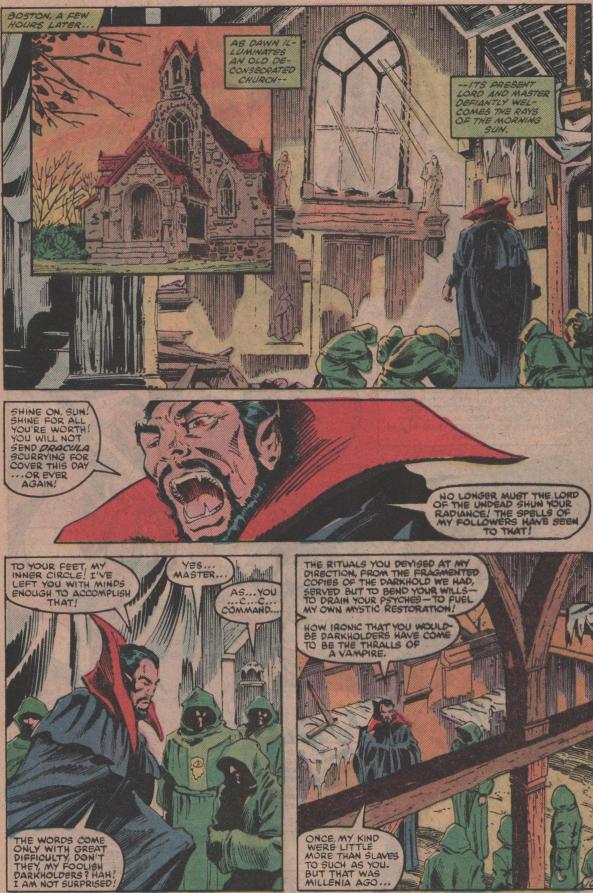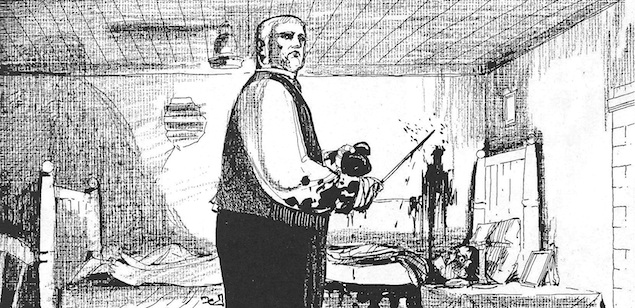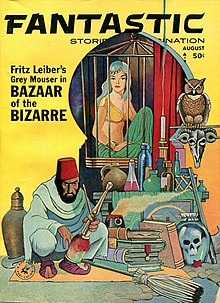|
|
Post by Cei-U! on Dec 19, 2018 12:19:08 GMT -5
Sorry for the wait. Kinda sick. Anyhoo... Tarzan and I go way back. As personified by Johnny Weismuller, he was one of my earliest ideas of a proper hero (alongside George Reeves’ Superman and Clayton Moore’s Lone Ranger). But I didn’t know the original Edgar Rice Burroughs version except for an occasional glimpse at the Gaylord DuBois-Russ Manning adaptations in the Gold Key title, which were for some eason hard to come by in my neck of the woods at the time. My next exposure came with the publication of 6. Tarzan #207-210 (DC, 1972) I knew Joe Kubert slightly, through reprints of his Brave and Bold Hawkman stories and the Cinq-Mars twins’ pile of DC war comics, but I never appreciated what a storytelling genius he was until I saw his adaptation of Burroughs’ 1912 pulp novel Tarzan of the Apes. Unlike the detailed clarity of Manning or Burne Hogarth, Kubert’s impressionistic approach gave the Ape Man’s origin a suitable mythic timelessness while remaining true in matters of dress and attitude to the era of its creation. This mood was greatly enhanced by Tatjana Woodʻs subdued, earthy color palette. Throw in the John Carter back-up stories by Murphy Anderson and Gray Morrow and you have an addictive brew guaranteed to nake a diehard ERB fanatic out of any impressionable 14-year-old boy. I collected all the Tarzan and Mars novels in college, and I’ve read a smattering of his other work (including a western) but I’ll never forget that first rush of discovery these four issues of Kubert’s Tarzan gave me. Kreegah! Cei-U bundolo! |
|
|
|
Post by MDG on Dec 19, 2018 12:33:22 GMT -5
6. Nightmare Alley
William Lindsay Gresham, Adaptation by Spain, Fantagraphics, 2003 Spain’s adaptation of William Lindsay Gresham’s novel is probably his longest work, and he dives into it with the same motion and excitement he brought to all of his comix.
This adaptation of Gresham’s noir-ish book about carneys and phony spiritualists follows the story pretty faithfully. While Spain’s style is modern (you could call it post-Marvel or post-Kirby), as opposed to some of his contemporaries like Crumb or Bill Griffith, whose styles hearken back to the comics of the 30s and 40s, it fits well with the story's sense of forboding and paranoia. It feels like what attracted him to the book was the portrayal of Lillith, a strong female character who plays the protagonist the way he played marks at the beginning of the story.  {More Art!}   |
|
shaxper
CCF Site Custodian
Posts: 22,860
|
Post by shaxper on Dec 19, 2018 12:34:34 GMT -5
6. Revolution on the Planet of the Apesby Ty Templeton, Joe O'Brien, Tom Fowler, Salgood Sam, and others (Mr. Comics, 2005-2006)  It was between this and Doug Moench's Marvel adaptation. For any of you who know how much I love Doug Moench, that should say something about this little known limited series. Whereas Moench took the basic premise of Planet of the Apes, threw several new casts of characters at it, and had fun just letting them walk around in it, experiencing one crazy new post-apocalyptic adventure after the other, Ty Templeton was an avid fan who dove into his POTA project with a mission. This was a deep, profoundly intelligent exploration of the series that sought to explain and fix weak aspects of a brilliant but highly flawed franchise. I've read this series three times now, and each time I take notes. Truly, I've given this thing far more thought than I ever gave the original series, and yet its concepts absolutely color my perceptions of the films and enhance my enjoyment of them whenever I rewatch them now. I reviewed this series years ago as part of my Planet of the Apes from the Beginning review thread project, and it was some of the most fun I've yet had reviewing a comic book series.
|
|
|
|
Post by Deleted on Dec 19, 2018 12:35:39 GMT -5
Get well soon, Cei-U! 6. Sonic the Comic I truly believe comic adaptations of video games don't work. Not for me. Video games are about interaction, achieving goals, etc. Reading comics is a relatively passive affair. With Sonic, who first appeared in 1991, it was about having fun on the SEGA console. Sonic was leaping about; you felt you wanted to leap about. How could a comic version, presenting static images on a page, possibly be so compelling? Well, somehow, Fleetway Editions/Egmont, managed to do that from 1993 to 2002. That's a not-unimpressive nine-year run. A fortnightly comic, the title featured a few strips in each issue, some of which focused on Sonic's supporting cast. Lots of writers and artists worked on it. There were even different artists within one issue. Despite that, it all felt very consistent. And the title managed to give the delightful little hedgehog a lot of personality. This is a comic I never desired, nor did I know I wanted it; now, I cannot imagine not having read it. If you Google the likes of London Editions Magazines and Fleetway (both part of Egmont), you'll see that a lot of UK comics were based on licensed properties. Very few managed a nine-year run. Some burned bright and quickly, e.g. London Editions Magazines published a He-Man comic - He-Man being a big thing in the 80s - but even that superlative title only managed a four-year-run. Very few video game comics lasted. Some probably lasted fewer than ten issues. That Sonic the Comic ran for nine years, in a crowded market, makes it worthy of inclusion on my list. And I found it a lot of fun. |
|
Crimebuster
CCF Podcast Guru
Making comics!
Posts: 3,958 
|
Post by Crimebuster on Dec 19, 2018 12:37:41 GMT -5
6. Glenn Scarpelli in Hollywood
6. Doctor Strange #58-62: The Montesi Formula(Marvel, 1983)  Following the end of the classic Tomb of Dracula series, Marvel put together what I would call a proto-event, as Dracula appeared in a number of different titles (including X-Men and Thor) across the company line before his saga was definitively tied up in the pages of Doctor Strange #58-62. In this story, Dracula and his minions embark on a quest to find the Darkhold, as it contains a spell that will remove the traditional vampire weaknesses, allowing Dracula to live in daylight — and wreak havoc on humanity. Teaming up with the Avengers, Blade, Hannibal King, and others, Doctor Strange works to thwart them, eventually using a spell called the Montesi Formula to destroy all vampires in the world. It's just a great read from Roger Stern, and a great crossover event from the time just before crossover events were a big, branded thing.  |
|
|
|
Post by DubipR on Dec 19, 2018 12:45:46 GMT -5
#6- FROM HELLWritten by: Alan Moore Drawn by: Eddie Campbell  Ripped from the headlines and books about the Jack the Ripper, Alan Moore and Eddie Campbell create an intricate story of what might've happened about the Whitechapel murders. Moore's research on the subject is extremely detailed and colored with his prose. Campbell's artwork is magnificent; that stark black and white art makes the book feel more creepier if it were in color. Part history, part magic and part horror story, the story of Jack the Ripper still holds people's imaginations to this day. 
|
|
|
|
Post by DubipR on Dec 19, 2018 12:48:53 GMT -5
6. Nightmare Alley
William Lindsay Gresham, Adaptation by Spain, Fantagraphics, 2003 Spain’s adaptation of William Lindsay Gresham’s novel is probably his longest work, and he dives into it with the same motion and excitement he brought to all of his comix.
This adaptation of Gresham’s noir-ish book about carneys and phony spiritualists follows the story pretty faithfully. While Spain’s style is modern (you could call it post-Marvel or post-Kirby), as opposed to some of his contemporaries like Crumb or Bill Griffith, whose styles hearken back to the comics of the 30s and 40s, it fits well with the story's sense of forboding and paranoia. It feels like what attracted him to the book was the portrayal of Lillith, a strong female character who plays the protagonist the way he played marks at the beginning of the story.    Consider this bought! Great choice! |
|
Confessor
CCF Mod Squad
Not Bucky O'Hare!
Posts: 10,197 
|
Post by Confessor on Dec 19, 2018 13:15:16 GMT -5
The Further Adventures of Indiana Jones (Marvel, 1982–1986)  Myself, I always felt that the Marvel adaptations of the three Indiana Jones movies were a little bit lacklustre (with Temple of Doom being arguably the best of the bunch). The Further Adventures of Indiana Jones, on the other hand, knocked my socks off right from the first issue! I initially encountered the series when it was reprinted as a back-up strip in Marvel UK's Star Wars Monthly and Return of the Jedi Weekly, back in 1982 and 1983. Although it had an ever revolving creative team, I suppose David Micheline of Star Wars and Amazing Spider-Man fame is the closest the comic ever had to a regular writer. The artwork too was mostly great, and was always interesting, beginning with some gorgeous John Byrne/Terry Austin work, before the likes of Ron Frenz, Herb Trimpe and the legendary Steve Ditko came on board a little later. What I really loved – and still love – most about this series though is that it "did what it says on the tin" (to quote a popular British TV advertisement). This was a comic that really felt like Indy's further adventures. It nailed the characterisation of the lead characters and totally captured the exciting, 1930s movie serial vibe of the films. You really did feel like you were experiencing missing chapters of the cinematic franchise when you read these comics, and really, can their be any better compliment for a film spin-off adaptation? 
|
|
Confessor
CCF Mod Squad
Not Bucky O'Hare!
Posts: 10,197 
|
Post by Confessor on Dec 19, 2018 13:19:51 GMT -5
#6- FROM HELLWritten by: Alan Moore Drawn by: Eddie Campbell Great pick! This never even occurred to me. I guess I was thinking of it as a historical graphic novel, rather than fiction, but, of course, it's a work of historical fiction really. This would've been right up there in the Top 3, had I thought of it. Damn! |
|
|
|
Post by Roquefort Raider on Dec 19, 2018 13:29:01 GMT -5
7. Tarzan of the ApesAdapted by Joe Kubert in Tarzan #207-210 DC comics, 1972  I must admit that Kubert is not my favourite Tarzan artist; I prefer Hogarth, and even before Hogarth I prefer Manning. But while their comic strip work is without peer, these gentlemen's comic-book efforts on Tarzan do not reach the same stellar quality, either because of poor reproduction in one case or the fact they were earlier work in the other). That being said, when I first read Tarzan of the apes in those first few issues at DC, it immediately became THE comic-book version of the Lord of the Jungle's origin as far as I'm concerned. No other attempt compares, not even the very good ones by other artists. Kubert masterfully blends grit and elegance in his jungle art. His wild forests never look as tidy as Manning's or Hogarth's, the action never looks staged, and he obviously cares very much for the subject. I had bought those issues for the John Carter back-up, at first, but I stayed for the main event.
|
|
|
|
Post by Deleted on Dec 19, 2018 13:29:31 GMT -5
You really did feel like you were experiencing missing chapters of the cinematic franchise when you read these comics, and really, can their be any better compliment for a film spin-off adaptation? Two of my upcoming choices were chosen based on that very aspect, Confessor! |
|
|
|
Post by Roquefort Raider on Dec 19, 2018 13:30:50 GMT -5
#6- FROM HELLWritten by: Alan Moore Drawn by: Eddie Campbell Great pick! This never even occurred to me. I guess I was thinking of it as a historical graphic novel, rather than fiction, but, of course, it's a work of historical fiction really. This would've been right up there in the Top 3, had I thought of it. Damn! Same here. Good thing there are other posters to highlight these books! |
|
|
|
Post by brutalis on Dec 19, 2018 13:40:40 GMT -5
#6- The Phantom Min-series #1-4. DC Comics 1988. Peter David, Joe Orlando, Dennis Janke.Adapting Lee Falk's Generational Hero, the Ghost Who Walks into comic book form. I knew of this jungle based pirate fighter but had never read anything other than the novels which I had found in a used bookstore one summer. I had heard of the Charlton series but never saw them at their time of printing and I also had never seen the newspaper comic strip (along with his friends Flash Gordon and Mandrake the Magician whom he would team up with in a television cartoon the next year) that I wished my paper would have carried. So seeing the ads inside DC comics for this min-series had my full attention and excited anticipation.
I grew up with Saturdays spent watching Weismuller Tarzan movies and Errol Flynn pirate movies so the idea of the Phantom was instantly something I wanted! This comic did not fail (as DC committed to an ongoing monthly the next year) for it was all I hoped for and wanted. It not only told a story of the current Phantom but delved into his history and family tree showing the origin and ongoing adventures of the Phantom role being passed on from father to son through the generations. This makes the Phantom one of the very first "LEGACY" type of characters and helps him stand out among the crowd of other jungle adventurers. Gunfights, fist fights, sword fights, animal fights: you name it and our purple clad dual ring wearing (one with flags marks you as friend, the other with skull marks you as foe) fighter of justice and Lord of the Jungle (you don't mind sharing the title do you Tarzan?) has it all.
|
|
|
|
Post by Deleted on Dec 19, 2018 13:52:20 GMT -5
On the Seventh Day of Christmas, Santa gave to me something from the Bazaar of the Bizarre…  Fritz Leiber's Fafhrd and the Gray Mouser #1-4 adapted by Howard Chaykin and Mike Mignola with inks by Al Williamson, published by Marvel/Epic; 1990-1991; collected by Dark Horse in trade in 2007 Adapting the stories of Fafhrd and the Gray Mouser by Fritz Leiber  The Lankhmar stories of Leiber are often lumped with other sword and sorcery tales, especially Howard’s Conan stuff, but the thematic underpinnings of Leiber’s stories couldn’t be more different than those of Howard. You’d never see Conan pining over a lost love like Fafhrd and the Mouser do in the Price of Pain Ease for instance, but the differences are what make these tales so appealing. It is still sword and sorcery adventure tales, but parts are a bit more tongue in cheek and the pairs foibles create a lot of their own problems. Chaykin brilliantly captures the spirit and voice of the stories in his adaptations (his second go round with the pair as he did some of the art on DC’s adaptations in Sword of Sorcery when he was just breaking in to comics in the early 70s), and Mignola is in top form capturing the weirdness and horrific elements of Lankhmar perfectly without losing some of the lighter tone this mismatched pair of adventurers bring to their stories. An Williamson’s inks on Mignola’s pencils are a joy to behold. -M |
|
|
|
Post by coke & comics on Dec 19, 2018 14:08:10 GMT -5
Get well soon, Cei-U! 6. Sonic the Comic I checked with Cei-U! that video game adaptations would be okay just so I could include this... and then it anyway missed my final cut. It was on all the early drafts of my list. So glad to see it! |
|